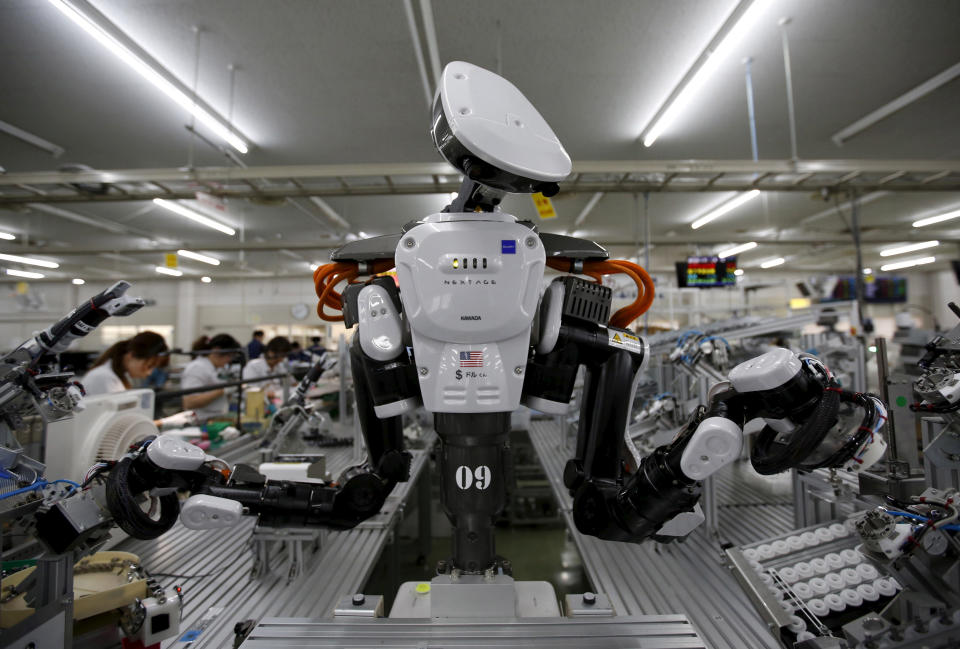51% of all job tasks could be automated by today's technology
Automation in the workplace has been one of the looming existential threats to American workers for years now. And with each new study published, the fear of robots, machines, and artificial intelligence coming to take our jobs ticks higher.
But a new report from McKinsey finds that the future of work and automation isn’t quite the zero-sum game when it comes to jobs as some perceive.
Right now, 51% of job activities could be automated with “currently demonstrated” technology, the McKinsey report says. The distinction is noteworthy: McKinsey isn’t saying half of all jobs can be automated with existing technology, but rather job tasks. Many jobs involve a blend of both the mundane and the intricate. Machines are excellent at handling rote, predictable tasks like repetitive physical labor and data collection and processing, making jobs like retail, foodservice, and manufacturing—a big theme in the 2016 campaign—most affected. As 51% of all working hours, these endangered activities make up $2.7 trillion in wages.

Because automation is spread out—less than 5% of jobs are entirely rote and machine replaceable—the changes will likely trickle in across the board. “About 60% of all occupations have at least 30% of constituent activities that could be automated,” the report says. “More occupations will change than will be automated away.” As for the timeline on this, McKinsey says its scenarios suggest 2055, but that it could happen 20 years sooner or later depending on economic conditions.
At first glance, this future, in which half your job is automated, seems to confirm John Maynard Keynes’s prediction of a 15-hour work week with more time for leisure. “Our analysis of automation potential also suggests that many occupations could be partially automated before they are fully automated,” the report says. For the workers caught in this shift who aren’t able to get trained for the new economy, it may be a 15-hour work week with a 15-hour work wage, without full-time benefits like health insurance. Or less than a 15-hour wage. “Especially for low-skill workers, this process could depress wages unless demand grows,” the study found.
As automation transforms individual tasks, workers will learn to perform activities that complement the work machines do (and vice versa), the study says. However, those jobs may not be performed by the same people—untrained for such tasks—who had their jobs slashed, leaving those people behind in the new economy. Today, many people in that situation—bookkeepers, for example—have fallen back on lower-paying jobs, which has led to the high employment and high income inequality today.
The report’s authors see a parallel with today. “We also assume that human labor displaced by automation would rejoin the workforce and be as productive as it was in 2014, that is, new demand for labor will be created,” the study says. “In any case, it is vital that there be new demand for labor displaced by automation.” Unfortunately, in the future scenarios, many of those lower-paying jobs are the exact same ones slated for automation.
The future the McKinsey report suggests isn’t the alarmist dystopia of permanent mass unemployment. Instead, it suggests that people who enter the workforce, or can adapt to it, after this jerk forward will face a starkly unsaturated job market. The demand for labor, it says, will be far greater than the supply many developed countries will be able to provide if they want to hit their GDP growth aspirations.
“Automation could provide enough of a productivity boost for them to achieve projected GDP for the next few decades,” the report reads. “This could more than compensate for the demographic changes that would otherwise likely slow down economic growth.”
Clearly, these gains may mean massive changes in how people work and earn money, changes that could leave millions stranded by the new economy and increase inequality even further. “Automation will cause significant labor displacement,” the study’s authors note. “and [it] could exacerbate a growing skills and employment gap that already exists between high-skill and low-skill workers.
To make sure gains aren’t only realized by shareholders, or that workers won’t lose, the study exhorts governmental policy changes that make sure the large numbers of people who lose their livelihoods are not left in free-fall. According to the study, governments should encourage and assist in training and education in STEM (science, technology, engineering, and math) as well as honing the human skills still out of the reach of the machines.
But the future may not end with work for everyone. “One of the challenges of the new era will be to ensure that wages are high enough for the new types of employment that will be created, to prevent continuing erosion of the wage share of GDP,” the study says. “If automation does result in greater pressure on many workers’ wages, some ideas such as earned income tax credits, universal basic income, conditional transfers, shorter workweeks, and adapted social safety nets could be considered and tested.”
Ethan Wolff-Mann is a writer at Yahoo Finance focusing on consumer issues, tech, and personal finance. Follow him on Twitter @ewolffmann.
Read more:
Bipartisan Committee: Killing Obamacare would cost $350 billion
Here’s who Donald Trump follows on Twitter — and who he has unfollowed
Robots will kill jobs and make inequality worse
Those brutally small airplane seats may soon be a thing of the past